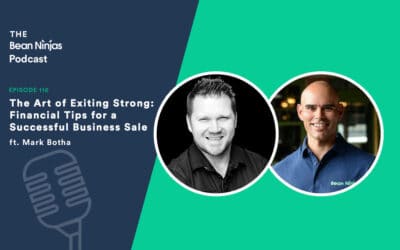
David Jenyns fired himself from his business, then tripled his bottom line. Here’s how he did it.
In Episode 61 of the Bean Ninjas Podcast, CEO Meryl Johnston talks to David Jenyns about how to systemise yourself out of your business.
What is the min. number of systems that need to be systemised in your business so that you can fire yourself? Listen in as @davidjenyns shares the answer. Share on XGetting into systems
Dave Jenyns is the founder of systemHUB, SYSTEMology and the Business Systems Summit. He became an entrepreneur after he finished school.
David got interested in the stock market. His goal was to find a way to make the most amount of money, although, he realised trading stocks wasn’t enough.
To have a good amount of money, he started importing products from the stakes.
He started creating digital courses, then he owned a R’N’R clothing store. Then he opened up two more, selling AC/DC T-shirts.
For a while, he worked in a supermarket and he explored so many different business options.
Later on, he got into online marketing and joined a business partner. They did a home study course to teach people how to trade the stock market.
At that point, you needed a certain amount of licencing to give financial advice, so Dave and his partner went separate ways.
Dave built a team with the focus of doing marketing, while he got into digital marketing. This led to setting up a digital marketing agency in which Dave was stuck over 10 years.
Dave became that busy business owner, who worked 70-80 hours work weeks and he decided he doesn’t want to live that lifestyle.
Dave was stuck in the business until his wife got pregnant, then he decided to make big changes
“I don’t want to be that dad who’s always too busy.”
Even when working from home, he wasn’t necessarily that present.
“I was always here, but I wasn’t always here, because I was thinking about business…I was just always working”
So, he used the idea of having kids as a catalyst for the change.
“When you’re in markets you don’t get emotional, you just follow your system or your process.”
He saw systems as a solution, so he could get less involved in the day-to-day business.
Related: What is Business Systemisation?
“For example, Google is always changing its algorithms and the online landscape feels like it’s changing every second week; I couldn’t systemise this business because it’s too much change.”
But systematisation wouldn’t fail if you create systems for the static components of the business. Systemise things that don’t change (like invoicing).
So, Dave started by trying to clearly define the minimum set of systems and processes. These systems and processes needed to be in place for the business to operate.
Then he needed clarity on who his target audience was and understanding what their problems were. This way he identified his primary product with goals of systemising it.
Dave Jenyns’ 7 steps to systemising yourself out of your business
“You don’t have to systemise everything out of the gate.”
As Dave says, you should focus on the core product of your service and do something that can be systemised. Reach a level of standardisation that can apply to every single business that you’re working with.
Dave’s focus these days is helping business owners step out of the daily operations of their business through some software and training.
He created a SEO starter pack to get anyone set up so that their online presence is pretty solid.
His business offers a range of different services. They’re for a particular person, solving a particular problem, and that makes it easy to systemise them.
“The real challenge is doing very custom work.”
Dave is still doing custom services but he’s shifting it further and further away with goals of transforming into productized services.
Related: A different approach to building business systems with Justine Pattantyus
“If everything changes every single time then you need someone who’s very, very skilled, who can customize it every single time, and usually, it ends up being the business owner.”
After hiring a CEO, Dave ended up running little groups of about 15 business owners. He was taking them through the process of implementing systems.
“How do we make this happen without the business owner being involved at every step of the way?”
“Systematisation isn’t urgent so it goes down on the priority list.”
Dave created a 7 step process around how you as a business owner can systemise your business and get out of the day-to-day operations.
Step 1. The critical client flow
Identify the central product that you want to systemise.
- How do you get customers?
- How do you engage them when that query comes in?
- What does the sale process look like?
- How you’re invoicing them?
- How you’re onboarding them?
- How you’re delivering the product or service?
- How are you getting them to come back?
Related: Preparing Your Business to Run Without You with Angela Henderson
Step 2. The assign phase
Assign responsibilities for different tasks and steps in the process that you’re identifying.
“Key is to identify, wherever possible, who has that knowledge that isn’t the business owner.”
The right time to systemise is when you have more than a few team members who can pass knowledge around.
This way you’re getting the whole team to complete tasks to a certain standard. Also, this means the business owner doesn’t have to be involved.
Step 3. The extraction phase
Systematisation is a two-person job; there’s a person that has the knowledge but might not have the time.
So, in this phase, you’re coming up with a flow or a process and you’re recording a certain team member doing a certain task.
Related: How to Systemize Your Business from Scratch
Step 4. Organisation
This step defines who does what by when.
You need a good tech stack; chose a platform where your team will store the “How To” documents.
“Key is to have a central place where all your knowledge is stored.’
Assign tasks to individuals and send them a How-To document that will explain how that task is properly done.
Step 5. Integration
This stage is for identifying if there’s resistance in the team. Help those members who are resisting change understand that this is a benefit.
For example, Team members can go on holidays knowing their tasks are being completed.
Say, a team member wants to bring more value to the business, he/she can easily do that by delegating systems and processes to other team members.
This will give you the capacity to take on higher quality work which brings more value to the business.
There will be challenges in the early transitioning and the building of the system culture. But, once you break through it gets a lot easier.
Step 6. Scale
In this step, you need to find out what are your key systems required for the core product or service.
- What do your financial systems look like?
- What are your weekly, monthly, annual tasks that need to happen in your HR?
- Hiring staff, onboarding staff, managing staff, your managing related systems
- What sort of reporting are you going to need?
Step 7. Optimisation
Define your key metrics.
Figure out which member is doing best at a particular task and get everybody performing this task to the standard of your best team member.
“When everybody is following the same process and we can start to make changes and see how it affects other parts of the business.”
“Business owners are great at solving problems and challenges. They see a problem in the world, create a product or a service to solve the problem, but then they get stuck in the operations and they start solving the same problem over and over and over again.”
So, after this last step, you iterate, improve and then that becomes a constant process. Adjust the system, reengineer the system, get consulting in certain areas.
When u get the basics the business owner can start solving higher quality problems, more strategically.
Related: Systematize: How To Build A Business That Can Run Without You
Here’s a video explaining systems in businesses:
The system doesn’t have to be perfect at first. Share on XIdentifying your CEO
Bringing In a CEO can be a challenging experience for a founder.
Dave was fortunate to recruit his CEO, Melissa, internally. Melissa and her husband were Daves’s business partners in the R’N’R clothing store.
At some point Melissa came to work with Dave again, so he had that level of trust. Also, Melissa understood what it takes to run a business.
“How do you find that person, you may already have them internally, you may have to recruit them. If you recruit for someone who is already a CEO or an operations manager it can be a very expensive role to recruit for. Depending on the size of the business, this may or may not be possible.”
You should look for someone with certain characteristics. Search for people with management skills, who are great with people, who can handle running projects, etc…
In Dave’s case, Melissa learned about the business and evolved in the CEO role.
“She had all of the strengths that complemented my weaknesses.”
Since Melissa was already in the business, she started working with me to catch all the processes until I could start handing some of the tasks over to her.
Dave is still involved in the business, he works a couple of hours a week.
“I can see all these opportunities that are right there in front of me and I have the space to take advantage of those.”
So now the question is: “What metrics and what numbers do I need to see to have the confidence that the business is performing well?”
We asked Dave how he defines financial freedom:
“The ability for the business owner to choose what it is that they are working on. They build up this business and they are the centrepiece they can’t take a break because they are so tied to the business that by them taking a break the business would fall over.”
So financial freedom for Dave is having the comfort to know that things are taken care of. This enables you to work on things that you’re truly passionate about.
“Systems and processes are your assets.”
Related: Building a business that works for you – Interview with Paul Higgins
“For more on building an asset, listen to our guest David Jenyns.” Share on XListen in to know more about systemising yourself out of the business.
Meryl and David discuss:
- Dave’s journey
- The benefit of systems
- The easy way to implement systematisation
- Characteristics to look for in a CEO
- Higher quality work
Resources mentioned in this episode
- Business Systems Summit
- David Jenyns (official)
- SYSTEMology
- systemHUB
- davidjenyns (twitter)
- Zoom
- Syshub
- Dropbox
- Google Drive
- Built to Sell
- Work the system
- Scaling Up
- Traction
Enjoying the show? Please subscribe & review in itunes
If you enjoyed listening to this episode and you want a really easy way to support the podcast, why don’t you head over to iTunes and leave us a quick rating or even a review? We would also love to hear what you thought of today’s episode.
Looking for an easy way to get there? Just go to beanninjas.com/podcastreview and that should open up iTunes on your computer. We read all your reviews, and it really helps other people to discover the show. Your support is very much appreciated.






